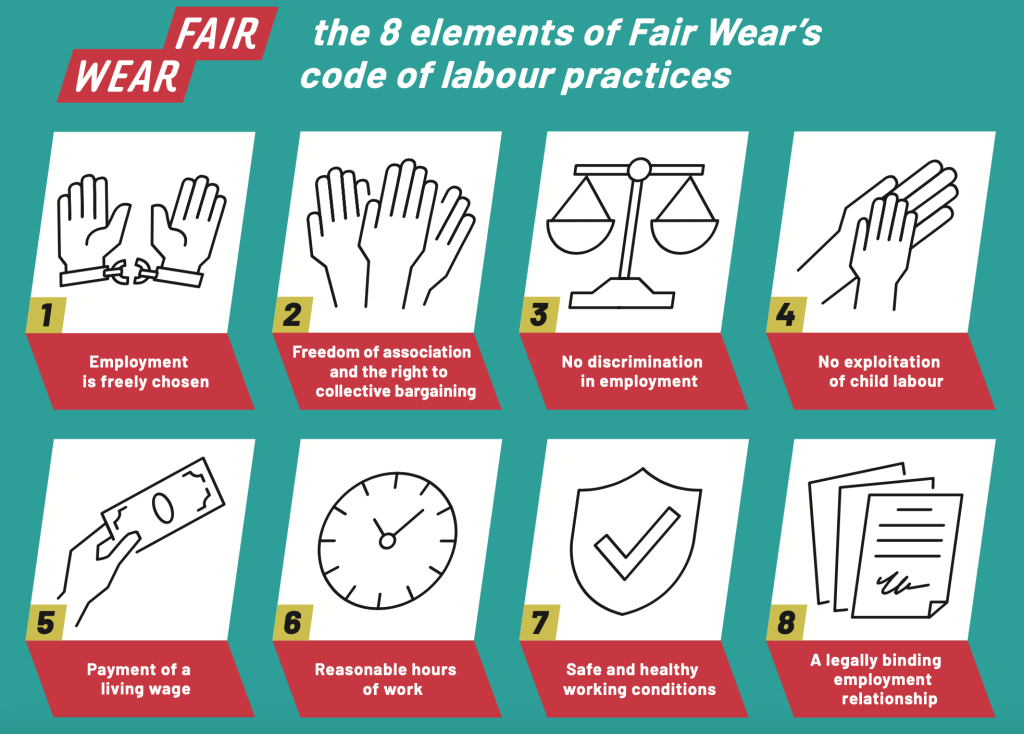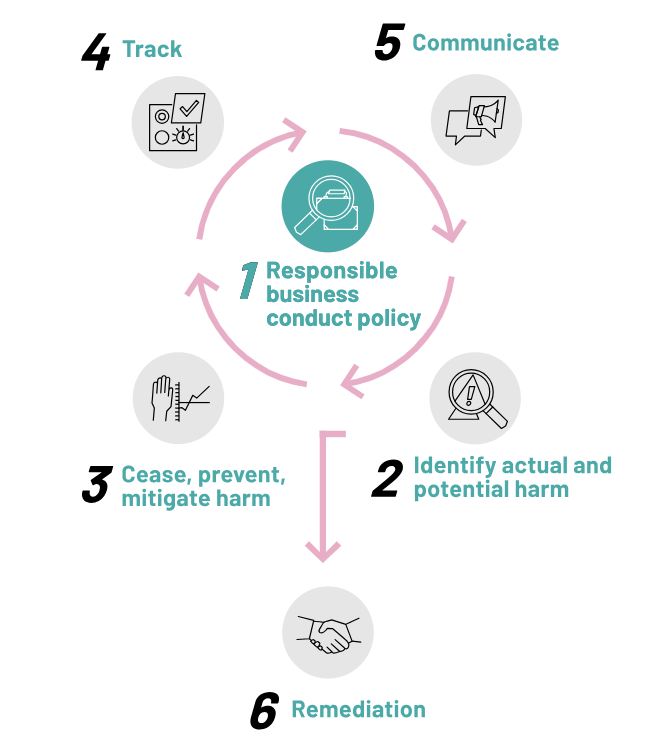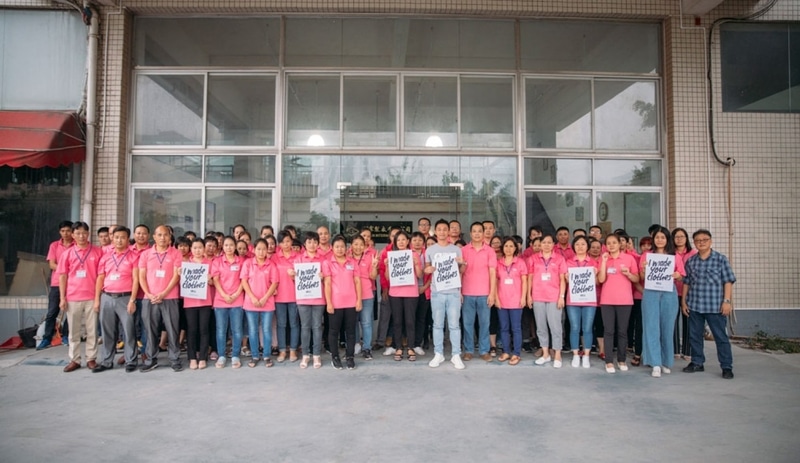Engagement environnemental et social
Human Rights Due Diligence
Article published on February 29, 2024

4 very important words that take a somber tone. With most of communication, we strive for that concise yet fun, sometimes cheeky tone. It makes serious and sometimes complex topics a bit more digestible. Today and with this topic, we are putting our serious hats on.
Picture upholds our suppliers, our partners, our stores, and our offices to Fair Wear Foundation’s 8 Code of Labor Practices (CoPL). We are committed to enforcing, monitoring, and improving upon these labor standards throughout our supply chain.

First, our supply chain refers to our CMT (cut-make-trim) manufacturers. Geographically our scope is Vietnam, India, China, Taiwan, Mauritius, Portugal, France, and Turkey, as these are our production countries. We would like to extend the same principles to partners beyond Tier 1 and beyond CMT, too. This expands the scope to suppliers like Mlife for our bottles and also, to our sourcing agents and their work.
The central point of HRDD policy is our responsible business conduct policy. The policy is simple:
We have the responsibility and a commitment to meet human rights throughout our business practices.
We use Fair Wear’s CoPL, international legislation, national regulations, the work of MSIs and our own company ethics to frame and meet these human rights. The expectations we have of ourselves, and our suppliers, are clearly laid out. One can see them repeated in our Code of Conduct and our sourcing strategy.
Our commitment is bolstered by top management at Picture. Here’s what Julien has to say: “We commit to following human rights due diligence. We will monitor and enforce practices and policies that prevent, react to, and remediate risks. This includes trying to make an equal, collaborative relationship between Picture and suppliers. This is a company commitment, not just a sustainability department commitment. As management, we must lead by example. We must stay aware of what is happening in our supply chain and take an active role in remediation.“
What is human right due diligence?
We use the definition from UNGP Guiding Principle 17 – “In order to identify, prevent, mitigate and account for how they address their adverse human rights impacts, business enterprises should carry out human rights due diligence. The process should include assessing actual and potential human rights impacts, integrating and acting upon the findings, tracking responses, and communicating how impacts are addressed. Human rights due diligence:
(a) Should cover adverse human rights impacts that the business enterprise may cause or contribute to through its own activities, or which may be directly linked to its operations, products or services by its business relationships;
(b) Will vary in complexity with the size of the business enterprise, the risk of severe human rights impacts, and the nature and context of its operations;
(c) Should be ongoing, recognizing that the human rights risks may change over time as the business enterprise’s operations and operating context evolve.”
The implementation
Now that we have defined and framed HRDD, we must understand our tools and strategies that implement HRDD. These tools are further supported and guided by our membership of Fair Wear. These tools help us to check in with our decision making and improve our internal procedures that ultimately impact the worker. We take actions to follow this cycle:

Here are all the tools to achieve the above diagram. It is not one specific tool to one specific step; they are used throughout. Still, we will attach a step to each of our actions.
- We have this document, our HRDD policy. Step 1
- We have a sourcing strategy that leads. It sets out multiple objectives but an important one to the HRDD process is that it focuses on creating long-term, good faith relationships. The strategy is more than just for new suppliers, it delves into how to maintain and use leverage with our current relationships to improve working conditions while making the best product of the highest quality. Step 1 and 5.
- We have a due diligence process for potential new suppliers. Our social and environmental criteria allow us to evaluate new potential suppliers clearly. This allows us to select suppliers that already fit the standards of HRDD. Step 2.
- We have a risk analysis, that is an overview of risks related to the production country, the garment industry, and our supplier. We look at the severity, likelihood, scale, scope, irremediably and the gender perspective. With this risk data, we can clarify if we are causing, contributing to and or are linked to the risk. This is updated when new information comes out and reviewed annually. Additionally, the Fair Wear risk scoping tool bolsters our risk analysis. Step 2 and 3
- Preventative actions. This differs from CAPs as CAPs are addressing identified issues. Preventative actions are based off the risk analysis from us and the Fair Wear risk scoping tool. If we know that forced labor is a common issue in a certain region of India, where we have a supplier or wish to have a supplier, then we can address this early on. We can understand the supplier’s policy on forced labor, on whether they use employment agencies or have instances of debt bondage; these are all factors that would lead us to believe that forced labor might or might not be happening. Preventative actions include our own brand practices, this is important for relevant departments specified below. For example, with excessive overtime, we can limit the possibility of it happening by giving feedback on time, by having appropriate production planning according to the supplier’s capacity and other actions according to the Common Framework for Responsible Purchasing Practices. Steps 3, 4, 6
- We have a Factories Follow Up excel. In this excel, we track our suppliers including data on social, environmental and other factors such as production capacity and order growth. We collect this data to help us prioritize action. This data is sourced from our Annual Supplier Survey and general communication. In this excel, there is a supplier rating in terms of social conditions, for environmental conditions and overall rating. Step 2, 3, 4, and 6
- We have specific CAPs (corrective action plans) for suppliers. From audits and discussions from suppliers, we have identified issues, the remediation and the timeline. When we detail out the issue, we have an internal process to understand how our brand practices have contributed to this issue, same as with preventative actions. We share this with our suppliers, who can adjust the CAP to their needs. We try to get the worker representative and or trade union representative to input on the CAP; however, this requires translation and the ability to approach the worker representative. Nonetheless, remediation should happen at the production facility with support from us. With CAPs, we like to work with other brands, Fair Wear members or not, who are at the supplier. Once an issue is remediated, we verify it with photos, videos, documentation and possibly a discussion with the HR manager or a manager at the supplier. We can also use audits or onsite assessments to verify if the issue requires it. Step 2, 3, 4 and 6
- We use social dialogue to build trust. Social dialogue is a trusted way to get all people involved, especially the workers. There are two parts to social dialogue. First, there is the dialogue we have between Picture and the partner, this must be honest. It is important to openly talk about Picture’s practices and how they might impact the supplier. Second, there is the dialogue between partners and their employees. It is the worker’s right to organize, express, and defend themselves. This dialogue is a space where terms of employment can be openly discussed. We will try to stimulate this later form of social dialogue through training, onboardings and conversations that emphasize Freedom of Association, worker committees, and the benefits of both. Steps 2, 3, 4, 5, and 6.
- We view collaboration as an action we can take. We strive to reach out and build partnerships with other brands to take stronger actions. This is enhanced by our participation in the LIC community to learn more about our purchasing practices and learn from other brands. Our work with other brands doesn’t mean we don’t take our own responsibility to act. Steps 1, 2, 3, 4, 5, and 6.
- Grievance mechanisms are an action where more voices can be heard and hopefully, acted upon. These mechanisms can be suggestion boxes, meetings with management, hotlines, and so on. We are willing to handle all complaints whether directly linked to or caused by Picture. The Fair Wear worker information sheet (WIS) with a hotline is posted in a visible location to all workers. Second, we will ensure that the supplier’s grievance mechanism is functional, and that the management is receiving, reviewing, and handling any complaints. Steps 2 and 4
- Fair Wear as a tool. Here we would like to recognize the highly skilled work of Fair Wear and their country teams across the globe. Steps 1, 2, 3, 4, 5, and 6
Roles and Responsibility
Sustainability team: touch every single step. We are the facilitators and bridge between Fair Wear, Picture team and our suppliers. To build a strong social dialogue between these parties, the sustainability team must be there! We are responsible for maintaining the risk analysis, factories follow up, specific CAPs, preventative action and training staff on these tools.
Product team: enact brand practices that ensure safe working conditions. Their work relates to preventative actions and social dialogue. For example, this team works with the sourcing agent to make sure feedback is delivered to suppliers on time, not leading to overtime hours.
Supply & logistics team: enact brand practices that ensure safe working conditions. Their work relates to preventative actions. For example, they work with the sales team to collect the forecasting data and make sure that it is sent out on time. Then, suppliers can make an accurate plan for their production.
Development team: enact brand practices that ensure safe working conditions. Their work relates to preventative action and social dialogue. For example, this team works with the sourcing agent to make sure feedback is delivered to suppliers on time, not leading to overtime hours.
Sourcing agents: an important communication point with our suppliers. They are connected to every step and a main voice when innovating, collaborating and negotiating with our suppliers.
These responsibilities and actions all build a path to becoming a responsible business. A responsible business includes meaningful engagement that is a two-way street and from the starting point of good faith and trust. It’s not necessarily a linear process, but an inclusive, integrated approach that is circular… and sometimes even topsy-turvy.
In conclusion, Picture is committed to the process and implementation of Human Rights Due Diligence for ourselves and our partners.
Digital signatures: Julien Durant, CEO and Florian Palluel, Sustainability Manager

